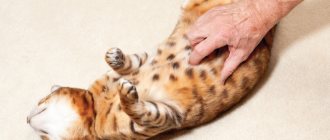Many owners tend to think that caring for a cat's teeth is unnecessary. And they don’t suspect that dental problems occur in cats no less often than in people. Caries is rare in cats, but tartar is a serious problem for many. The owner must know how to brush a cat’s teeth and how to teach him to do it. Regular cat oral hygiene not only protects against the formation of lime deposits, but also significantly reduces the risk of developing serious dental problems: gingivitis, stomatitis, periodontitis.
Brushing your cat's teeth: is it necessary or not?
Pets do not lead the same lifestyle as their wild counterparts, so it is important to follow certain tips and recommendations when caring for them. More than half of cats over three years of age suffer from periodontal disease - inflammation of the bone tissue of the teeth to which the crowns are attached. First, the gums become inflamed (gingivitis) due to plaque accumulating on the teeth, because bacteria develop there. When plaque persists, tartar is formed from it, and microbes develop many times more actively in it. When a stone comes into contact with the gum, it greatly irritates it, which often causes inflammation. A pet with advanced disease often loses teeth.
Cats whose owners do not brush their teeth may develop other problems:
- Bleeding gums;
- Caries;
- Decreased appetite;
- Unpleasant odors from the mouth;
- Your pet's mood may become depressed;
- Diseases of the digestive organs occur because putrefactive bacteria penetrate there from the oral cavity.
If compared with wild cats, then the situation is radically different. They constantly hunt and eat solid food, so the enamel is naturally cleared of deposits. Tough pieces of meat do not usually get stuck in the teeth like the soft foods that indoor cats eat.
How dangerous is tartar for a cat?
This is an aesthetic problem and bad breath, drooling, rotting food debris in the cavities and interdental spaces. The cat loses its well-groomed appearance, begins to smell bad, and the chin and around the lips become wet due to constant salivation.
Tartar provokes a number of pathologies:
- gingivitis, periodontal disease (loose, bleeding gums);
- stomatitis;
- caries with tooth decay under a layer of calculi;
- gastritis, gastroenteritis (develop due to the fact that the cat cannot fully chew food);
- periodontitis, osteomyelitis (the inflammatory process spreads to the periosteum and jaw bone, which literally dissolves).
The most difficult option in the practice of a veterinary dentist is precisely the last case. When it is virtually impossible to save a tooth, it has to be removed and the pus and necrotic tissue removed. And since tartar forms in layers and affects several teeth, the jaw, left “without dental support,” literally falls off like soft plasticine.
Cleaning a cat's teeth at home: with what?
To clean your pet's mouth, you can use a special toothbrush for animals. On sale are:
- Toothbrushes with curved handles for ease of cleaning the mouth;
- Brushes that fit well and comfortably in the hand;
- Finger guards are brushes that can be placed on your finger.
If you don’t have a special one, you can use a soft children’s toothbrush. The bristles should fall just below the gum line. In extreme cases, it is appropriate to use gauze or a cotton swab.
Cat Teeth Cleaners
Pet pharmacies and veterinary stores sell special toothpastes for cleaning cats' teeth. They contain harmless substances, and cats really like the smell of the products.
Is it okay to use human toothpaste?
It is strictly forbidden to use the products on people, as they contain substances that should not be swallowed. A person can resist swallowing, but a cat can’t do that. If such a paste is swallowed, the pet may suffer, as its digestive system will receive substances harmful to it.
Is baking soda good for cleaning?
Baking soda contains a lot of alkali, which disrupts the acid balance in the stomach, so it should not be swallowed. The pet may not like the taste of the product, so it will break out and will not allow its teeth to be brushed.
Rules for brushing teeth for cats
There is a proven scheme for manipulation:
- A gel for cleaning teeth is applied to the brush;
- The pet’s head should be held at an angle of 45 degrees, the cat’s lips should be carefully lifted, the mouth may not be opened;
- First you need to clean the large back teeth and fangs, since plaque forms there most often;
- Actions must be slow and careful;
- Gradually you need to clean all the crowns;
- Cleaning takes approximately 30-60 seconds on each side;
- You should not rush through the procedure; caution is important so that the animal does not get scared.
Using a fingertip to brush your teeth
If you don't have a brush, you can use a fingertip. It is recommended to proceed according to the same scheme. Before starting the procedure, it is necessary to accustom the cat to the fact that the owner’s finger can be in his mouth. To do this, you can do a slight massage of the gums.
How to prepare your cat for the procedure
Accustoming to the procedure of brushing teeth should be gradual, regardless of the age of the cat. You shouldn’t try to get into your pet’s mouth and put things in order the first time - a small predator is unlikely to like this, and such aggressive actions will form in him a negative attitude towards cleaning, which will significantly complicate further training. You need to act step by step and carefully:
- Invite your cat to get acquainted with new objects - let him sniff a brush or a tube of cleaning product. You can dispense a small amount of paste and let it taste.
- Start getting your pet used to having their teeth touched. To begin with, simply placing your fingers on your teeth will be enough. Be sure to reward your animal with a treat every time for being patient.
- Gradually increase the time your finger remains on your teeth. When the cat sits calmly in this position, you can begin to make circular movements with your finger.
- Once you have achieved a calm reaction from your cat to your finger, you can try replacing it with a brush. Applying the paste to the bristles will make your pet more interested in the process. To prevent the cat from immediately licking off all the product, when squeezing it out, push it deeper to the base of the bristles.
It is important to carry out all manipulations in a calm environment, finding the cat in a good mood and well-being. If the animal refuses to participate, there is no need to force it, it is better to try again later.
We teach your pet to brush its teeth from a kitten
It is easier to accustom a small kitten to the procedure. If the cat is an adult, the procedure will take more time. At first this will cause certain difficulties, but then the pet will get used to it, so it will not pay attention to the procedure.
There are certain recommendations that, if followed, will help accustom your kitten to brushing its teeth:
- You need to find a quiet place where you can place your pet. The door should be closed so as not to leave him an escape route. You can carry out the procedure on your knees or by placing your pet on a table covered with a towel.
- A cotton swab should be dipped into the tuna liquid. Cats love the taste and it will be a good association with brushing their teeth in the future.
- It is necessary to lift the animal's lips; the teeth need not be opened.
- Use a cotton swab to rub your lips and the edges of your gums.
- If your pet is nervous, you don’t have to try to treat all the teeth; you can start with a few.
- When the kitten gets used to it, you can start brushing procedures.
Professional teeth cleaning for cats
Once a year, it is recommended to bring your pet to the veterinary clinic to evaluate the condition of the oral cavity. If inflammation or other problems with the gums are detected, appropriate treatment will be prescribed to stop the disease in a timely manner.
Stones on teeth
If the pet is shown to a specialist in a timely manner, the stones will be detected and removed on time. When they occur, you should immediately take the cat to the appropriate specialist. The means by which it is proposed to remove the stone at home do not show any effectiveness at all. They help prevent its appearance, but will not help remove solid formations.
To clean teeth from stones, the cat is put under anesthesia or the procedure takes place without it. The second option is suitable for pets who behave calmly, open their mouths and do not resist.
The most commonly used technique is ultrasonic teeth cleaning. The procedure is quite expensive, but the enamel is preserved without damage. For cleaning in this way, anesthesia is required.
Before anesthesia, the pet must be examined and the necessary tests are done to determine how the injection will be received. This is especially important for kittens and older pets. The dosage must be selected correctly.
Caries
Caries is a dental disease that must be treated. This is done through a filling or crown removal. The second option is more common.
How to brush a cat's teeth
We've sorted out the need to clean the oral cavity, let's talk about how to properly brush your teeth and gums at home, how often to do this, and in what cases professional cleaning is necessary.
How often should you clean
At home
Veterinarians recommend brushing cats' teeth at least once a day.
We understand that it is difficult to find time for this.
But there is a way out, since now it is not necessary to clean with toothpaste and a brush; then we will talk about alternative methods.
The procedure is necessary for animals of any age, since dental plaque forms from the first months of life.
Professionally
It is necessary to visit the veterinary clinic once a year for a professional cleaning.
If cats have sensitive gums and their teeth are in poor condition, they may require more frequent professional care. The timing of the next cleaning at the clinic is determined by the veterinarian.
What you need for cleaning
To safely and effectively clean your pet’s teeth, you need to prepare:
- A special toothbrush for cats with soft bristles. These are sold in pet stores and veterinary pharmacies.
- Silicone finger brush.
- Veterinary toothpaste with a pleasant taste.
- Napkins made of soft cloth or gauze.
Never use human instruments or products to clean an animal's mouth. Toothpaste suitable for humans is toxic to cats.
How to properly brush your cat's teeth at home
You need to start the cleaning procedure in a calm state and with a positive attitude. Cats sense the owner’s mood; if a person is worried and not sure of the result, the animal will also become nervous.
- Sit next to your cat and pet him affectionately, touching his face, cheeks and the area around his mouth.
- When the animal calms down, you can treat it with a treat.
- Dip your finger into your pet's favorite wet food and let your cat lick your finger.
- Gently touch the animal's gums with your finger. Take your time so that your pet doesn’t get nervous.
- Squeeze some veterinary toothpaste onto your finger, let your cat lick it off, and then rub the paste onto his gums.
- After this, squeeze a little toothpaste onto a special toothbrush for animals and gently brush several teeth. To expose the teeth, gently lift your pet's upper and lower lips.
- Start with the back teeth, gradually moving towards the front.
- If your cat doesn't resist, continue brushing the remaining teeth.
- If the animal does not like the brush, try carrying out the procedure with a damp gauze cloth.
- Take breaks for affection and treats; the cat must be constantly encouraged and praised.
- If the cat does not give in or shows resistance, ask someone to help you hold the animal or wrap the pet in a towel.
Spend as much time as your pet needs to get used to brushing his teeth. Take your time, do not scold the animal if it resists. It is important to develop a positive attitude towards these manipulations in your cat. If she associates these not entirely pleasant actions with something pleasant, the process of addiction will pass quickly and painlessly.
Process video
At what age should cats be taught to brush their teeth?
Cats do not like it when a person tries to get into their mouth, so they need to be accustomed to this unpleasant procedure from a very early age. There is no need to postpone this process “for later”; as soon as the kitten gets into your home, start training it. Then in the future you will be able to brush the teeth of an adult cat without any problems.
Act consistently, but slowly. Take a break from training for a few days if your cat is stressed.
Alternative cleaning method
An alternative means for cleaning gums and teeth is disposable wet wipes.
This is the easiest way to cleanse. Just wrap a napkin around your finger and wipe your incisors with it.
At the end of the procedure, the napkin is disposed of; the napkins cannot be reused.
Dental wipes are impregnated with organic substances that remove plaque and prevent bad breath. This method helps save time for cat owners. But you have to pay for convenience and simplicity.
The cost of such napkins is from 400 to 900 rubles.
Sanitary napkins for cleaning teeth:
- Show Tech Dental Wipes;
- Japan Premium Pet.
The cleaning process at home should not take more than 30 seconds a day.
Ways to support oral hygiene
Cleaning your cat's teeth is possible not only with brushes, but also in other ways. There are special dry foods on sale that are suitable for cleaning cats' teeth. They contain substances that prevent the formation of tartar on the teeth. Their structure is such that mechanical cleaning of the crowns is ensured.
You can buy teeth cleaning treats that cats like to eat. Teeth cleaning pads for pets have a hard surface that cleans the canines. The composition contains active components that destroy plaque and help eliminate bacteria.
There are special oral fluids on the market. They have a cleansing effect and also the ability to eliminate unpleasant odors. They are added to cat drinks. Manufacturers say that the composition of the drugs is harmless to the gastrointestinal tract of cats.
Alternative Cleaning Methods
For kittens who cannot get used to being cleaned, you can choose other methods.
- Special toys that are designed to strengthen gums. They are soaked or filled with catnip, which relieves inflammation and soothes itching in the mouth during teething.
- Treats in the form of biscuits , sticks or seeds marked “Dental-snack”. Due to their dense consistency, they mechanically remove plaque and massage the gums.
- Dry food whose granule shape is designed to prevent the formation of plaque and stones. The vitamins and minerals included in these feeds strengthen the teeth and oral mucosa.
Useful tips
- There are a lot of bacteria in the animal's mouth, so it is recommended to wear gloves when brushing teeth;
- The toothbrush should be washed thoroughly after the procedure;
- The brush needs to be replaced every 3 months;
- If there are several cats in the house, then each one requires a separate brush;
- Animal feed must be of high quality;
- Before cleaning, you need to let the cat smell the paste;
- The procedure should be accompanied by praise.
If it is not possible to remove plaque regularly, then you can buy special treats - sticks, pads for cleaning cats' teeth.
Frequency of procedures
It is better to accustom cats to brushing their teeth from a young age - in this case, the animal will get used to it faster and in the future will perceive the procedure much more calmly. Therefore, it is advisable to begin acquaintance with a brush and paste from the moment all baby teeth appear - at 8-12 weeks. For such a baby, procedures 1-2 times a month will be enough, but with mandatory regularity. After changing the dentition, you can brush more and more often, gradually approaching the regularity recommended by veterinarians - 1-2 times a week.
A mandatory step in caring for your cat’s teeth should be systematic visits to the veterinary dentist - once a year will be enough. The specialist will examine the oral cavity and, if necessary, give additional recommendations or make adjustments to the actions taken by the animal owner regarding the health of his teeth.











